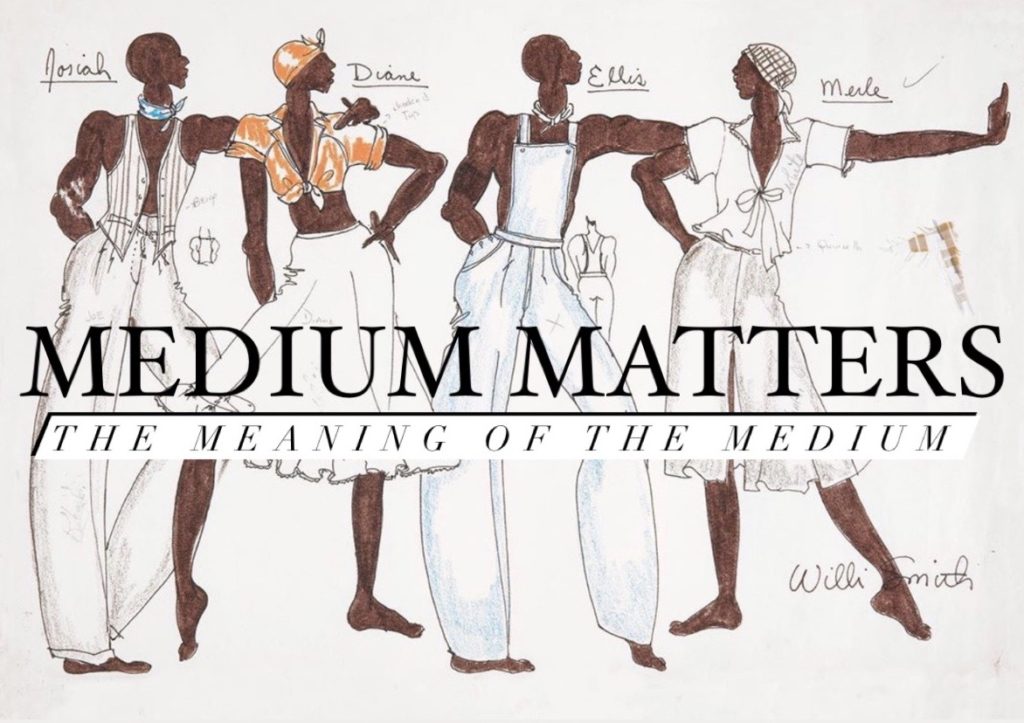
Some snippets from our research on the meaning of the medium …
‘… no medium is singular or autonomous: by definition mediums are go-betweens. The second proposal, which follows from the first, is that mediums exist only in relation to one another, within a matrix, and as a means of communication rather than purely as abstract, (self-)reflexive entities. The third is that mediums should not be considered in a reductive but rather in a generative light … The fourth is something we all know but I would like to consider differently, and that is that painting … has historically been prime among such mediums, and prime among them in emphasizing the materiality of medium. Fifth, and finally, mediums are not only their materialities but also their histories – their histories of thought about medium and materialities’. p. 123-4, Carol Armstrong, “Painting Photography Painting: Timelines and Medium Specificities” in Graw, Isabelle and Ewa Lajer-Burcharth, eds., Painting Beyond Itself: The Medium in the Post-medium Condition, (Sternberg Press, 2016)
‘Societies have always been shaped more by the nature of the media by which men communicate than by the content of the communication’. p. 8, McLuhan, Marshall, The Medium is the Massage: An Inventory of Affects, (New York, 1967)
‘We must address the image not only as a product of a given medium, be it photography, painting or video, but also as a product of ourselves, for we generate images of our own (dreams, imaginings, personal perceptions) that we play out against other images in the visible world’. p. 2, Hans Belting, An Anthropology of Images: Picture, Medium, Body (Princeton University Press, 2011)
‘The materiality of photographs takes two broad and interrelated forms. First, it is the plasticity of the image itself, its chemistry, the paper it is printed on, the toning, the resulting surface variations […] Second are the presentational forms, such as carte de visite, cabinet cards, albums, mounts and frames, with which photographs are inseparably enmeshed […] Both these forms of materiality carry another key element, the physical traces of usage and time’. p. 4, Elizabeth Edwards and Janice Hart (eds.), Photographs, Objects, Histories: on the materiality of images (London: Routledge, 2004)
‘It is an essential fact that without the constant reference of its interpretation, fashion could not be perceived. Certain ways of looking could not be seen as more desirable than others, as acceptable or in need of subversion of further exaggeration, without the visual demonstration that pictures provide’ p. 350, Anne Hollander, Seeing Through Clothes (New York: The Viking Press, 1978)
‘What is new about new media comes from the particular ways in which they refashion older media and the ways in which older media refashion themselves to answer the challenges of new media.’ P. 15, Bolter, J. D. and R. Grusin, Remediation: Understanding New Media (Cambridge: MIT Press, 2000)
‘The allure of fashion media lies, in part, in the way they conjure the tactile, sensual associations of being dressed – the feel of fabric against the skin, the weight and drape of clothing as it moves with the body. If the address to the corporeal body is key to the way that fashion media become meaningful, then (how) is this privileged relationship with the body extended and enabled with fashion interactives?’ p. 176, Eugenie Shinkle, “Fashion’s Digital Body: Seeing and Feeling” in Fashion Interactives, in Fashion Media: Past and Present (Bloomsbury, 2013)
‘Clothing, as an extension of the skin, can be seen both as a heat-control mechanism and as a means of defining the self socially. In these respects, clothing and housing are near twins, though clothing is both nearer and elder; for housing extends the inner heat-control mechanisms of our organism, while clothing is a more direct extension of the outer surface of the body’. Pp. 119-20, McLuhan, Marshall, Understanding Media: The Extension of Man (New York, 1964)

